Measurement procedures in vacuum technique:
N.B. 2) is performed by means of pressure measurements (1), at two ends of a tube with a known conductivity.
![]()
There is no universal gauge that can measure from atmosphere to UHV pressure a (dynamic range of 1015). The instrument chosen depends on the pressure range and the residual gases in the vacuum. Mechanical gauges in which solid or liquid diaphragm is moved by the gas molecules hitting it, give absolute pressure measurement unaffected by gas properties Unfortunately they are ineffective below 10-5 Torr.
Gauges which measures some bulk gas property, such as heat conduction or viscosity, are dependent on gas composition and are effective over limited pressure range below approximately 100 Tr and above 10-4 Tr. Gauges for high vacuum and ultra high vacuum are generally based on charge collection, that is the residual gas molecules are ionised, and the resulting current measured. Although such gauges will ionise vapours as well as permanent gases, their response depends on parameters other than ionisation potential, making accurate total pressure measurement difficult in a gas mixture.
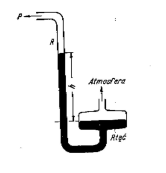
3.1.1 Barometers
1) Toricelli vacuum meter
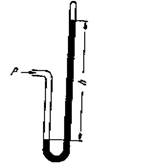
2) Closed barometer -for the lower pressures.
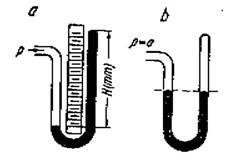
3) “Shortened” barometer.
4) Mechanical membrane gauge.
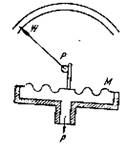
5) Compressing absolute barometer (McLeod) Fig: 7a
insert figure:
Operation principles:
Bring the Hg level in the compression capillary 1 to y-y. The Hg level in the reference capillary 2, identical to 1, will be higher, at the line z-z. Equilibrium condition: p2=H+p1 in [Tr] units, where H is the difference between the Hg levels in 1 and 2. The compression ratio, k=V1/V2, is set by the ration of the volume of the container 3 (V1 , known and constant for a given gauge) to V2=(p/4)d2h.. In the equilibrium conditions p1V1=p2V2, i.e.,
![]()
![]()
where ![]() is the gauge constant. Typically
is the gauge constant. Typically ![]() , and the measured pressure
, and the measured pressure ![]()
In the linear method (case a, see figure) we keep the level difference constant h=h0. Then:
![]()
In the quadratic method (case b) we compress to have H=h, and
![]()
We want the compression ration k to be as high as possible, therefore we want d to be as small as possible, but there is an obvious limit to reducing d. The best realistic k » 104-105, allowing for measuring down to p » 10-6 Torr.
N.B. This is an absolute pressure gauge - important for calibration of relative vacuum meters.
The gauge can operate either with mercury or with vacuum oil. There is a problem of contamination by the measuring agent and false effect due to the pumping by liquid. N2 traps located at the system input.
Principle of operation Fig 7b
S - static plates are heated to T’, R - rotary plates at T
In an ideal vacuum the plates would remain parallel. At the presence of the gas in-between the plates, the difference in velocity of molecules scattered from the hot plates and from cold gauge walls generates a torque momentum.
From the side of the static plates the force /unite surface of a R plate is
![]()
From the opposite side, the R plates feel the force:
![]()
The net force:

![]()
The constant depends on the type of the gas through the accommodation coefficient (depending also on the state of the surface). The coefficient b accounts for thermal energy transfer - non-perfect scattering. A particle scattered from the surface at temperature T does not fully accommodates the speed corresponding to that temperature.
Measuring range is limited by :
On the low pressure the limiting factor is electromagnetic radiation. plim»10-6 Torr On the high pressure the limiting factor is the viscosity of gas. plim »10-1 Torr.
Fig. 7c.
Gas molecules execute torque momentum on the measuring disk. The torque transfer efficiency depends on the gas pressure. The pressure is measured by examining the torque applied on the upper disk. In some gauges the discs are magnetically suspended.
Pressure range: 10-2 - 10-6 Torr
Heat conductivity of a gas depends on its pressure (through the number of molecules) The basic idea is shown in Fig 7d:
Current carrying Pt or W wire (D) changes its resistance with changing temperature:
![]()
![]() ,
, ![]()
If the current through the wire is kept constant then the voltage drop![]() will be a measure of the pressure. That is a constant current gauge. The opposite case: the voltage is maintained constant by adjusting the bias current (which is a measure of the pressure). That is a constant resistor gauge.
will be a measure of the pressure. That is a constant current gauge. The opposite case: the voltage is maintained constant by adjusting the bias current (which is a measure of the pressure). That is a constant resistor gauge.
Power delivered to the wire ![]() is dissipated by:
is dissipated by:
For low-pressure 2) and 3) start to dominate and set the measurements limit.
The relation V=f(p) is obtained from the calibration curve.
In the laboratory practice the calibration is obtained by setting: V to Vmin (beginning of the csale) at p=760 Tr and V to Vmax ,(full scale) at p=0. p=0 in practice means p<10-5 Tr – e.g., an operating diffusion pump.
Zoology of heat conductivity meters:
insert figure
The pressure range between 10 and 10-3 Torr is indicated by measuring the voltage of thermocouple spot welded to a filament exposed to system gas. The filament is fed from a constant current supply, though its temperature depends on thermal losses to the gas. At higher pressure, more molecules hits the filament and remove more heat energy’ causing the thermocouple voltage to change. These gauges are used extensively in fore-line monitoring and to provide the signal to automatically switch the main chamber from backing and high-vacuum pumps at the crossover pressure.
In a Pirani gauge two filaments, often platinum, are used as resistance in to arms of a Wheatstone bridge. The reference filament is immersed in a fixed gas pressure, while the measurement filament is exposed to the system gas. The current through the bridge heats both filaments. As in T/C gauge, gas molecules conduct heat away from the immersed filament and unbalance the bridge. Pirani gauges have roughly the same pressure measurement range as T/C gauge and are used in identical application, but generally provide faster response.
3.2. Ion vacuum-meters
For pressures lower then 10-3 Tr all measurement are based on ionising gas molecules and measuring the ion current. Ionisation is achieved by
N.B. Sensitivity depends on the type of gas through deferent ionisation efficiency º No. of ions created by 1 electron along the path of 1 cm at the pressure of 1 Tr.
If the gauge sensitivity for air is 1 then:
He |
H2 |
N |
Air |
N2 |
O2 |
CO |
A |
CO2 |
Hg |
5 |
3 |
2.5 |
1 |
0.9 |
0.9 |
0.9 |
0.8 |
0.7 |
0.3 |
The gauge measures the ion current collected by the collector circuit. Measurements with ion gauges bear an error due to a spurious effect of pumping by ion adsorption in the gauge body.
Bayard – Alpert head
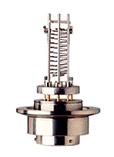 Covers the range between 10-4 to 10-9 Torr, with gauge sensitivity from 5 to 20 Toor-1. B-A gauges are available with one or two filaments (the second acting as a spare) and with two filaments material: thoria-coated iridium, used in oxygen reach application and for ‘burn-out’ resistance if the gauge is dumped to atmospheric, and tungsten, used for lower cost and in residual gases containing halogen.
Covers the range between 10-4 to 10-9 Torr, with gauge sensitivity from 5 to 20 Toor-1. B-A gauges are available with one or two filaments (the second acting as a spare) and with two filaments material: thoria-coated iridium, used in oxygen reach application and for ‘burn-out’ resistance if the gauge is dumped to atmospheric, and tungsten, used for lower cost and in residual gases containing halogen.
B-A heads are available in naked and dressed version, see Fig 7f,g
VA » 100 - 150 Volts
Vc » -25 - -75 Volts
Ie » 10 mA - 10 mA
Gage constant k (Tr-1)
![]() ,
, ![]()
typically k »10 - 30 Tr-1 , therefore for for Ie » 1 - 5 mA s » 10 Tr/A.
N.B. The ion current in a B-A head is about an order of magnitude smaller then the pressure in Tr.
The B-A gauge’s lower pressure limit (10-9 Torr range) is caused by emission of the soft X-ray radiation generated by primary electrons hitting the anode. X-ray photons reaching the ion collector electrode release photoelectrons. The electron current due to photoemission is indistinguishable from the ion current of the positive ions collected by the collector electrode. Below 10-9 Torr the photoemission current becomes a large enough fraction of the ion current to distort the pressure reading (for vacuum 10-12 Tr. we have to measure current of 10-13A!). Below 10-9 Tr the collector current is:
![]()
where ![]() is the X-ray contribution. In order to have the measurement error < 10%:
is the X-ray contribution. In order to have the measurement error < 10%: ![]()
Therefore, the low pressure limit for the B-A head:
![]() , ~ 10-9Tr range.
, ~ 10-9Tr range.
Readhead gauge
B-A head with extended measuring range: Redhead gauge equipped with an additional thin wire modulator electrode located within the anode, see Fig 7j.
The procedure consists of taking take two measurements with different potential VM of the modulator:
1) Set VM =VA and measure Ic’
2) Set VM =Vc and measure Ic’’
Assuming that the X-ray contribution to both measurement is the same
![]() and
and ![]()
Obviously, k’>k’’ and
![]()
Redhead low pressure limit falls into 10-11 - 10-12 Tr range.
Other low pressure extended range gauges
Groszkowski - screened collector protected by a tube against X-rays see Fig 7h.
Helmer-Haynord - applies magnetic field and bends the ion beam towards the hidden collector
Lafferty - magnetic field assisted ionisation + bending.
Cold cathode glow discharge head (Penning)
Low pressure limit -- problems with ignition and glow maintenance. Same solutions use spark plug to start. At the high pressure side the limiting effect is the arc discharge. Range - 5*10-3 - 5*10-7 Tr.
Partial pressure measurement - spectroscopy of the gas composition
Separation of masses can be performed by :
3.3.1. Magnetic field
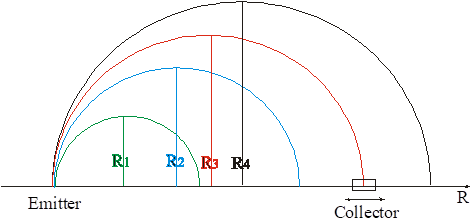

![]()
![]()
Solutions:
H = constant M0U = constant
R = constant M0U = constant
3.3.1.1. 180° mass spectrometer
Insert graph:
Typical spectra for air at 10-9 Tr: Spectra of DC 704 vacuum oil vapour.
H2 |
2 |
H2O |
18 |
CH4 |
16 |
N2+CO |
28 |
O2 |
32 |
Ar |
44 |
Resolution: ![]()
S1 and S2 are the apertures of the emitter and collector boxes. Observe that we cannot reduce s1 and s2 below certain limits because the overall sensitivity will decrease.
Typically: ![]()
The principle is based on a cyclotron resonance of charged gas molecules
Electric field between electrodes P1-P2 =Ecos(wt), electrons- flow from cathode K to anode A along (x-x’ path.), Gas ions are created along x-x, and accelerated by the electric field, in the presence of magnetic field. The cyclotron resonance frequency:
![]()
At the resonance condition ions move along opening spiral tracks and each the collector. The resolution
![]()
The Omegatron is a simple and a small device, e.g., 20x20x20 mm. Typical parameters:
Ie ~ mA, H ~ 3000 Oe, E ~ 10 V/cm, w for 2<M0 < 100 2.3 MHz to 43 kHz, ![]() ~ 10-20
~ 10-20
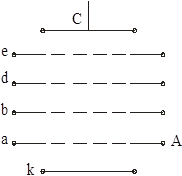
kA - ionisation by dc electron current .
ab - acceleration of the ioos by dc voltage
electrodes b-d and d-e biased with ac electric field in opposite phases
This type of mass spectrometer has low resolution.
Build around four rods through which the ionised gas particles are flowing. Between each pairs of rods there is a voltage difference V0+Vcos(wt).
Analysis is performed at w = const and at changing V/V0 ratio.
Collector is reacted only by ions with a mass: M0~V/w2
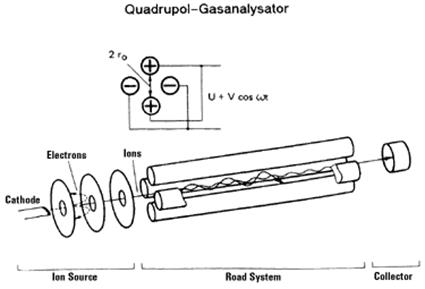
Square shape accelerating pulse; all particles acquire the same energy but due to difference in mass they have different time of arrival to the collector.
Measurement of collector signal in time. Big complicated but good resolution:
![]() >100
>100
Leak detector = mass spectrometer tuned permanently to He + a pumping unit. (diffusion pump or TM based). The pumping unit has precise tuning of the pumping speed (throttle valve) in order to provide optimum measuring condition for various leaks.
In-side vs. outside operation (sneezing) .
Source: http://physweb.bgu.ac.il/COURSES/ExperiMethods/lecture_notes/1_3_Vacuum_measurement.doc
Web site to visit: http://physweb.bgu.ac.il/
Author of the text: indicated on the source document of the above text
If you are the author of the text above and you not agree to share your knowledge for teaching, research, scholarship (for fair use as indicated in the United States copyrigh low) please send us an e-mail and we will remove your text quickly. Fair use is a limitation and exception to the exclusive right granted by copyright law to the author of a creative work. In United States copyright law, fair use is a doctrine that permits limited use of copyrighted material without acquiring permission from the rights holders. Examples of fair use include commentary, search engines, criticism, news reporting, research, teaching, library archiving and scholarship. It provides for the legal, unlicensed citation or incorporation of copyrighted material in another author's work under a four-factor balancing test. (source: http://en.wikipedia.org/wiki/Fair_use)
The information of medicine and health contained in the site are of a general nature and purpose which is purely informative and for this reason may not replace in any case, the council of a doctor or a qualified entity legally to the profession.
The texts are the property of their respective authors and we thank them for giving us the opportunity to share for free to students, teachers and users of the Web their texts will used only for illustrative educational and scientific purposes only.
All the information in our site are given for nonprofit educational purposes